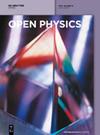提高 Al2O3、ZnO 和 TiO2 二元纳米流体在传热应用中的稳定性
IF 1.8
4区 物理与天体物理
Q2 PHYSICS, MULTIDISCIPLINARY
引用次数: 0
摘要
这项研究的主要目标是提高纳米流体的稳定性,这对于在各种应用中保持一致的热物理性质至关重要。纳米流体的稳定性对于在应用过程中获得均匀的热物理性质至关重要。X 射线衍射和 zeta 电位对三种纳米粒子(即 TiO2、Al2O3 和 ZnO)进行了表征。为了提高纳米流体的稳定性,实验工作经过了多次试验。最初,实验使用去离子水作为基液进行稳定性分析,但纳米粒子在 5 小时后就会聚集。其次,实验选择碱性水作为基液,在 7 至 14 的不同 pH 值范围内分析纳米流体的稳定性。最后,还研究了添加表面活性剂对制备的纳米流体稳定性的影响。观察结果表明,与其他 pH 值相比,纳米粒子在 pH 值为 11 时表现出更高的稳定性。这种稳定性可归因于高 zeta 电位促进了单个颗粒之间的静电排斥。结果表明,添加表面活性剂后,(TiO2 + ZnO)和(Al2O3 + ZnO)的 zeta 电位分别从 -44.2 mV 上升到 -47.8 mV 和 -42.4 mV 上升到 -44.1 mV。加入表面活性剂后,(Al2O3 + TiO2)的 zeta 电位略有下降,从 -47.7 mV 降至 -44.9 mV。本文章由计算机程序翻译,如有差异,请以英文原文为准。
Stability enhancement of Al2O3, ZnO, and TiO2 binary nanofluids for heat transfer applications
Primary goal of this research is to enhance stability of nanofluids which is vital for maintaining consistent thermophysical properties during various applications. Nanofluid stability is essential for obtaining the uniform thermophysical properties during its application. X-ray diffraction and zeta potential were performed to characterize three nanoparticles, namely TiO2 , Al2 O3 , and ZnO. Experimental work was carried out under several trials to enhance the stability of nanofluids. Initially, deionized water was used as base fluid for stability analysis, but nanoparticles agglomerate within after 5 h. Second, alkaline water was selected as base fluid at different pHs ranging from 7 to 14 to analyze the stability of the nanofluids. Finally, the effect of surfactant addition on the stability of prepared nanofluids was also investigated. Observations revealed that at pH 11, nanoparticles exhibited enhanced stability compared to other pH levels. This stability can be attributed to the high zeta potential, fostering electrostatic repulsion between individual particles. It was concluded from the results that zeta potential increases in cases of (TiO2 + ZnO) and (Al2 O3 + ZnO) from −44.2 to −47.8 mV and −42.4 to −44.1 mV with the addition of surfactant, respectively. In the case of (Al2 O3 + TiO2 ), zeta potential decreases slightly from −47.7 to −44.9 mV with the addition of surfactant.
求助全文
通过发布文献求助,成功后即可免费获取论文全文。
去求助
来源期刊

Open Physics
PHYSICS, MULTIDISCIPLINARY-
CiteScore
3.20
自引率
5.30%
发文量
82
审稿时长
18 weeks
期刊介绍:
Open Physics is a peer-reviewed, open access, electronic journal devoted to the publication of fundamental research results in all fields of physics. The journal provides the readers with free, instant, and permanent access to all content worldwide; and the authors with extensive promotion of published articles, long-time preservation, language-correction services, no space constraints and immediate publication. Our standard policy requires each paper to be reviewed by at least two Referees and the peer-review process is single-blind.
 求助内容:
求助内容: 应助结果提醒方式:
应助结果提醒方式:


